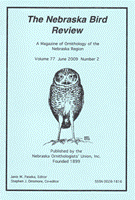Nebraska Ornithologists' Union

Nebraska Bird Review
Date of this Version
3-1999
Document Type
Article
Citation
Dinsmore, "Two Winter Records of Pacific Loons at Lake McConaughy" in Nebraska Bird Review (March 1999) 67(1).
Abstract
Pacific Loons are rare migrants in Nebraska, with most of the recent records coming from the western half of the state. Many of the recent records are from Lake McConaughy in Keith County and from Lake Minatare in Scotts Bluff County. Most records are from fall in the short period between 20 October and 20 November. There is a single spring record from April, 5 summer records in the period June to August (all but one from western Nebraska), and a few fall records outside the peak period. The latest fall record from Nebraska is 9 December. In this note, I detail two January sightings of single Pacific Loons from Lake McConaughy.
On 2 January 1998, I was scanning the rafts of Western Grebes above Kingsley dam when I spotted a distant loon. I studied the bird from 3:45 to 4:30 p.m. Even at a great distance, the bird was clearly a small loon, slightly larger and longer-necked than a Common Merganser. The shape of the bird was distinctive: fairly short, stocky body and a long-necked, puffy-headed appearance. The bill was very short and stocky, and I estimated the length was less than the length of the head. Because of the great distance, many details of the plumage were difficult to observe, but I noted the very dark-backed appearance, the sharp line of demarcation between the light foreneck and darker nape, and the dark area around the eye. On 3 January, I relocated the bird off the south end of Kingsley dam under much better viewing conditions. At this distance, the bird was easily identified as a Pacific Loon in first-basic plumage. The dark mantle and upperwings were edged with pale buff color. The neck pattern included a white foreneck with a thin dark chinstrap, a dark gray crown and nape, and a darker black line separating the two. The color of the nape was slightly paler than the mantle. The bird remained in this area through at least 15 January and was seen by several other birders.


Comments
Copyright 1999, Nebraska Ornithologists' Union. Used by permission.